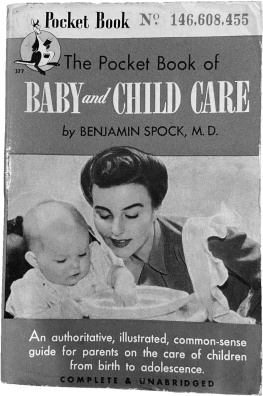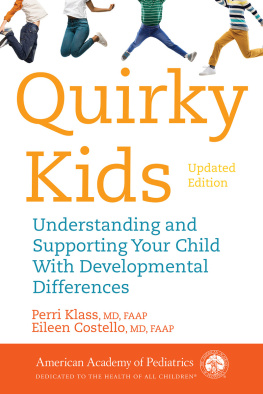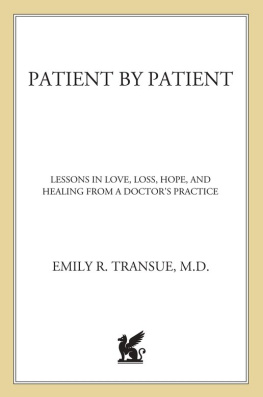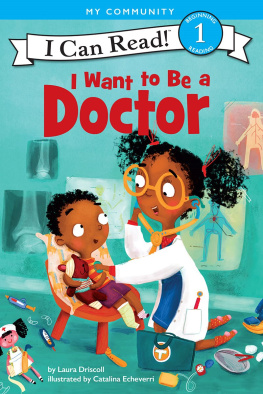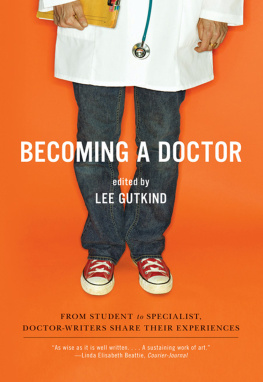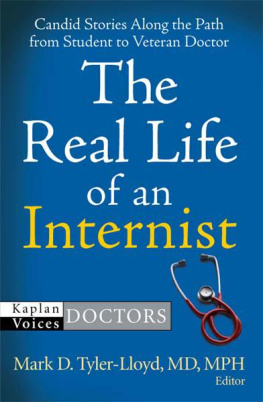C ONTENTS
I NTRODUCTION
Perri Klass, MD
B APTISM BY F IRE
Alenka Zeman, MD
T HIRSTY
Michael Patrick, MD
M Y M ENTOR W AS A S WINE
Stacy Beller Stryer, MD
P ATH TO P EDIATRICS
William Borkowsky, MD
W HOS R ESPONSIBLE H ERE?
Suzanne Dixon, MD, MPH
C UBA
Lee Savio Beers, MD
W HAT D O Y OU T ELL THE A SPIRING P EDIATRICIAN?
Bryan Vartabedian, MD
J AZMINE
Christine Gleason, MD
F ORSAN
Dipesh Navsaria, MD, MPH, MSLIS
T HE C ARE OF S TRANGERS
Rachel H. Kowalsky, MD
S HIFTING S ANDS
Perri Klass, MD
T HE M ISSING P IECE
Huy Quang Nguyen, MD
D OUBLE -T ALK
Eileen Costello, MD
P AULAS S TORY
Mariana Glusman, MD
T HERES A B UG IN Y OUR H EAD
Patrick McDonald, MD, MHSC, FRCSC
T HE G IFT OF S IGHT
Diego Chaves-Gnecco, MD, MPH
W HY?
Joy Marasco Neyhart, DO, FAAP
T AP
Sayantani DasGupta, MD, MPH
M OTHERHOOD
Lee Savio Beers, MD
C LOSE C ALLS
Perri Klass, MD
I NTRODUCTION
Perri Klass, MD
P EDIATRICIANS HAVE GOOD stories to tell. The essence of pediatrics involves the most remarkable and most basic human story: the growth and change that takes each of us from newborn infant to child to adolescent to young adult. Every aspect of that growth and change informs at least some part of pediatrics; collectively, we pediatricians take as our professional property everyone from the premature newborn baby who weighs less than a pound to the high school football player who stands well over six feet tall and weighs in at more than 200 pounds. No other field in medicine includes patients separated along this logarithmic scale the 1-kilogram baby (a premature infant weighing just over 2 pounds), the 10-kilogram child (22 pounds, a very nice weight for a toddler), and the 100-kilogram adolescent. Its our job, collectively, in pediatrics, to worry about the illnesses and injuries across all those ages and sizes.
Pediatrics is a relatively new field in medicine, dating back to the middle of the 19th century, and it is founded on the principle that, as they repeat over and over to us during our training, children are not small adults. Abraham Jacobi, the founding father of pediatrics, put it this way: Pediatrics does not deal with miniature men and women, with reduced doses and the same class of diseases in smaller bodies. it has its own independent range and horizon and gives as much to general medicine as it receives from it. In the diseases and dangers that confront them, in their remarkable resilience but also in their vulnerabilities, in their responses to medications in all of these ways, children are distinct and different, and their health care presents special challenges and conundrums.
As children are not small adults, it is also worth remembering that, as the World Health Organization puts it, health is more than the absence of disease. When you take care of childrens health, you worry, of course, about preventing and treating illnesses and injuries and chronic diseases, but you also think constantly about how to foster and promote healthy development and everything that should come with it, from play and pleasure to learning and language.
We who practice pediatrics at this particular time and in the comparative luxury of a developed country are privileged to be practicing at a remarkable historical moment. Thanks to public health and hygiene, and especially to vaccines, we can watch our patients grow up free of many of the dangers that all through history have caused infant and child mortality and that still hurt and kill children in many parts of the world. As recently as my own parents generation, doctors and mothers and fathers had to worry about polio, about measles and rubella, about infection and paralysis and brain damage and death. My own oldest child was not protected as an infant against bacterial meningitis because the HIB vaccine only came along in time for his younger sister; as a resident, I took care of children with meningitis and worried that there was no way to protect my own son. The conquest of the vaccine-preventable infectious diseases doesnt mean that parents can stop worrying, of course, or that pediatricians can stop worrying. Part of the job of child rearing involves worrying about the safety and well-being of each and every profoundly beloved and profoundly vulnerable baby and part of the job of pediatrics involves appreciating that the parents have in turn entrusted you with that baby, that child, even that teenager.
A newborn baby is a pediatric patient and in fact, everyone begins the career of being a pediatric patient as a newborn baby. However, there is not a single newborn baby anywhere who has ever come in alone to see the doctor every pediatric patient comes in the context of a family, brought in by parents, grandparents, or other caregivers. And part of the great privilege of practicing pediatrics is the sense of being woven into many lives, many families, and many stories. For pediatricians, that means being included over and over in those moments of astonished recognition that happen as children grow: yes, this rambunctious 5-year-old was that tiny, helpless baby; yes, that self-conscious, gangly 12-year-old has become this gracious young adult. I find myself identifying over and over with parents in their pride and their delight and, of course, in their anxiety and sometimes in their grief.
Its also our role to see our patients through the age of pediatric expertise and then say good-bye to them as they grow into adulthood. Put simply, one great job and one great joy of pediatrics is watching our patients outgrow us; our goal is to shepherd them safely through childhood and into adulthood, and then pass them on to other doctors who will worry about the medical issues of those grown-up years. And this is true in every area of pediatrics, including pediatric oncology and neurosurgery we all want to see our patients outgrow and outlive our period of expertise. It isnt at all true in adult medicine, which necessarily and properly includes the end of every patients lifespan as part of the territory. In pediatrics, we want our patients to grow up and leave us behind.
Medical careers reflect their own trajectories of growth and change, and there are stories here that describe the different developmental stages of a life in pediatrics. William Borkowsky looks back on the conversations and decisions that took him into the field of pediatrics and talks about the influence that teachers and mentors can have. Bryan Vartabedian finds himself thinking about how he can best play that same role for a young student, by example and by advice.
Medical training involves so many stages of increasing knowledge and increasing responsibility. Alenka Zeman tells the story of finding herself in charge of a terrifyingly ill child. As a resident, covering at a community hospital, she must take care of a child who may be about to die; the childs grandparents are looking to her to handle the situation. Its over whelming, its frightening, its impossible and its her job. Michael Patrick tells another story out of training, in which an intern picks up a chart in the emergency room and finds himself caring for a dangerously ill child and trying to reassure the mother.
There are essays here that reflect a tremendous variety of locations and situations, all of them places where children are growing up and pediatricians are caring for them. Stacy Stryer describes a rather unusual training situation as she gets ready to practice on a remote Navajo reservation; Lee Beers describes practicing on a military base in Guantnamo Bay. But whether the pediatrician is Joy Neyhart in Alaska or Rachel Kowalsky in a New York City emergency room, the connections to individual children and individual families are paramount, and these essays are also about trying to understand the story and the circumstances of a particular family.


